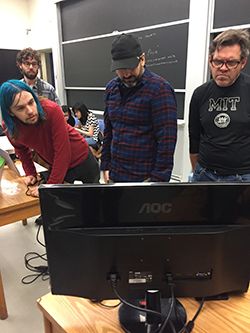In this section, Kyle Keane and Andrew Ringler discuss two dispositions they hope participants will develop as a result of participating in the workshop.

Andrew Ringler (far left), Mark Vrablic (second from left), and Kyle Keane (second from right) problem-solving with a workshop participant (Image by H. Sharon Lin, MIT OpenCourseWare).
Empowering Participants to Value Themselves as Learners
If participants leave this workshop knowing how to use Unity to make video games, that’s great, but we don’t expect that. Technical skills take a long time to develop; you can’t turn people into developers in two weeks. But you can teach life skills in that time, so one of our goals for this experience is for participants to leave the workshop valuing themselves as learners. We want them to leave the workshop saying, “I can do this on my own. I don’t need an instructor to teach me everything.” If they develop confidence in their ability to find answers on their own, that’s a success.
We intentionally use the Unity game engine in this workshop because it has a rich online ecosystem of documentation and tutorials. We begin the workshop by having participants complete two or three of these tutorials. Encouraging participants to find resources on their own helps them begin to realize that that they don’t need us, as instructors, to direct their learning experience.
To further help them develop a sense of self-efficacy in this realm, we do a lot of behavioral modeling. When they have questions, we sit down next to them and say things like, “I’m going to Google how to switch scenes in Unity. Feel free to do it with me.” Or, we’ll say, “That’s a really complex problem. We’re going to have go to our teaching assistant [Mark Vrablic], who’s really good at this stuff.” We could probably solve the participant’s problem on our own, but we think it’s more important that they not feel stupid for getting to a place where they need to ask for help. It’s better to coach them and to model how to bring in others to solve problems.
We’re strong advocates of this approach because we know there are social needs in a classroom that trump cognitive needs. If you don’t address those social needs, it makes it nearly impossible for participants to learn, because their nervous systems start sending alarming messages, like, “Do I look like an idiot?” When that happens, they’re not able to chomp on high level concepts. Everything we do in the classroom is aimed at disarming students’ nervous systems so they can believe in themselves as learners.
Giving Permission to Reframe Creativity
"Creativity is not aways about coming up with completely original ideas."
Another goal we have for participants is that they free themselves, at least a little bit, from restrictive ideas about creativity. We tell them, explicitly, that creativity is not always about coming up with completely original ideas. Building something that already exists and then tweaking it is how you learn. It’s how you gain the skills needed to take the work in new directions.
We use our course design—which involves students mimicking, step-by-step, projects that have already been built and then deviating from them—to give students permission to build on existing work. This is important because there’s a stigma around copying projects. If you’re learning how to draw, and you trace a picture instead of drawing it freehand, you feel like you’re cheating. And we don’t believe that at all. So we design the curriculum to reflect our belief that taking what’s been done and modifying it in order to learn is actually very productive. If learners expand their perspectives about creativity as a result of participating in the workshop, we feel successful.










